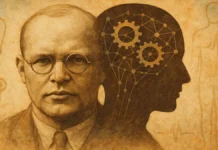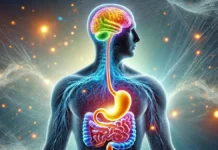Introduction
Alchemy and osteopathy, although often seen as distinct disciplines, share a fundamental perspective on transformation and health, adopting a holistic approach that considers the human being as a whole.
Alchemy, several centuries old, is at once a science, a philosophy and an art. It is often associated with the transformation of matter, but it also encompasses the transformation of spirit. Its principles are based on the idea that the universe is composed of fundamental elements that can be transformed and purified to achieve a state of perfection. Transmutation, that is, the transformation of one substance into another, is at the heart of alchemical practice. However, this transformation is not limited to matter; it also aims at the spiritual elevation of the individual. Alchemy seeks to unify opposites, symbolized by symbols such as the Sun and Moon, masculine and feminine, to achieve a state of harmony and wholeness.
Similarly, osteopathy takes a holistic approach to health by viewing the human body as an interconnected whole. Founded in the 19th century by Dr. Andrew Taylor Still, osteopathy is based on the principle that health results from the balance between the structure, function and physiology of the body. Osteopaths use manual techniques to assess and treat structural imbalances, such as muscle tension, joint restrictions and energetic blockages, which can disrupt the body’s optimal functioning. By restoring mobility and balance, osteopathy promotes the body’s natural ability to self-heal and maintain health.
Although alchemical and osteopathic practices differ in their specific methods and goals, they share a commitment to transformation and harmony. Both recognize the importance of considering the individual as a whole, taking into account their physical, emotional, mental and spiritual aspects. By adopting a holistic approach, alchemy and osteopathy offer unique pathways to personal transformation and well-being, encouraging the individual to explore and cultivate their deepest potential.
The alchemical stages
The alchemical stages, often depicted as processes of transmutation of raw matter into spiritual gold, are rich in symbolism and meaning. Their correlation with the principles of osteopathy can provide an interesting framework for understanding the healing process. Here is an explanation of the main alchemical steps and their relationship with osteopathy:
- Calcination :
This step involves burning the raw material to reduce it to ashes. Symbolically, it represents purification and liberation from impurities. In osteopathy this can be compared to removing tension and blockages in the body, allowing vital energy to flow freely. - Dissolution :
Dissolution consists of dissolving the ashes resulting from calcination in a liquid. This symbolizes the dissolution of old forms to allow new possibilities to emerge. In osteopathy, this can be interpreted as releasing patterns of tension and pain, allowing the body to reorganize itself towards an optimal state of health. - Filtration :
At this stage, impurities are filtered out, leaving behind a purer substance. This represents the process of clarification and discernment. In osteopathy, this can be associated with awareness and release of patterns of stress and tension that hinder the healing process. - Conjunction :
Conjunction symbolizes the union of opposites, the merging of opposite aspects to create a new whole. This can be compared in osteopathy to the harmonization of opposing forces in the body, such as tension and relaxation, to restore balance and health. - Fermentation :
This process involves transforming the resulting substance into something new and more dynamic. In osteopathy, this can be linked to the body’s ability to self-regenerate and heal, transforming dysfunctional patterns into renewed vitality. - Distillation :
Distillation involves separating the more volatile elements from the substance, leaving behind a more concentrated essence. This can be compared in osteopathy to the ability to distinguish and treat the root causes of imbalances in the body, thereby enabling deep and lasting healing.

By combining alchemical principles with osteopathic concepts, one can see how each step of the alchemical process can be interpreted as an aspect of the healing process in the human body, thus emphasizing the importance of a holistic approach to restoring balance and health.
Conceptual parallels
Alchemy and osteopathy, although originating from different contexts and practices, share several conceptual commonalities that illustrate their holistic approach to health and transformation. Here are some of these parallels:
- Search for root causes :
Both in alchemy and in osteopathy, there is a constant search for the root causes of dysfunctions. In alchemy this translates into the quest for the “essence” or true nature of substances, while in osteopathy it involves identifying and treating the underlying causes of imbalances in the body, rather than to simply suppress the symptoms. - Importance of balance and harmony :
Both disciplines place great importance on balance and harmony in the body. In alchemy, the goal is to achieve balance of opposing forces to achieve transformation and enlightenment. Similarly, in osteopathy, health is considered to result from the balance between the structure, function and physiology of the body. - Holistic Approach :
Both alchemists and osteopaths take a holistic approach to health, considering the human being as a whole, including physical, emotional, mental and spiritual aspects. In alchemy, personal transformation involves the union of spirit and matter, while in osteopathy, healing is facilitated by treating the body as a whole, rather than isolated parts. - Principle of Correspondence :
Both disciplines recognize the principle of correspondence, whereby what happens in the physical world reflects deeper truths in the spiritual world. In alchemy, processes of transformation of matter are often interpreted as metaphors for the spiritual development of the individual. Likewise, in osteopathy, physical imbalances can reflect emotional or mental imbalances, and vice versa. - Process of Transformation :
Alchemy and osteopathy share an interest in the process of transformation, whether it is the transmutation of metals into gold in alchemy or the healing of illnesses and imbalances in the body in osteopathy. In either case, this process often involves purification, clarification, and reorganization to achieve a higher state of health and harmony.
In summary, alchemy and osteopathy have many conceptual parallels, highlighting their shared view of health as a state of balance and harmony, achieved through the process of transformation and holistic healing. These similarities underline the importance of considering the human being as a whole and seeking the root causes of dysfunctions to promote optimal well-being.

Holistic approach
Alchemy and osteopathy, although in different fields, share a holistic approach to health and well-being, recognizing the importance of considering the individual as a whole. Their common goal is to restore balance between body, mind and soul to promote optimal health and well-being.
In alchemy, this holistic approach manifests itself through the vision of man as a complex entity, composed not only of physical matter, but also of emotional, mental and spiritual aspects. Alchemists consider that the transformation of matter is intrinsically linked to the transformation of the mind and soul. Thus, the search for the elixir of life or the philosopher’s stone is not limited to the quest for physical longevity, but also aims to achieve a state of enlightenment and spiritual realization. Alchemical symbols, such as the union of opposites or transmutation, represent this search for harmony and balance at all levels of being.
Similarly, osteopathy takes a holistic approach by viewing the body as an interconnected entity, where health results from the balance between structure, function and physiology. Osteopaths recognize that imbalances in the body can have emotional and mental repercussions, and vice versa. So when they evaluate and treat a patient, they consider not only the physical symptoms, but also the emotional, mental, and environmental factors that may contribute to the illness or dysfunction.
In both disciplines, the holistic approach also involves a deep understanding of the interrelationships between body, mind and soul, as well as the use of treatment methods that aim to restore harmony and balance in all these areas. In alchemy, this can manifest through meditative or contemplative practices aimed at purifying the mind and elevating consciousness. In osteopathy, this can result in the use of manual techniques to realign the body and release energetic blockages that hinder the natural flow of vital energy.
Practical application
Integrating alchemical concepts into osteopathic practice offers a unique perspective on how transformation and healing can be facilitated. Here are some examples of osteopathic techniques and approaches that reflect alchemical principles:
- Manual Techniques as a Means of Transformation :
Osteopathic techniques, such as joint manipulation, tissue mobilization, and myofascial release, can be interpreted as means of physical transformation. By applying these techniques with awareness and intention, osteopaths can help release tension and blockages in the body, allowing a transformation to a state of increased health and balance. - Meridian and acupuncture point work :
Some osteopaths incorporate traditional Chinese medicine concepts into their practice, using techniques such as acupressure or meridian stimulation to balance energy flow in the body. This can be compared to the alchemical idea of circulating and transforming vital energy through the body to promote health and well-being. - Psychosomatic approach :
Osteopathy recognizes the interrelationship between the physical, emotional and mental aspects of health. By integrating relaxation, visualization and meditation techniques into practice, osteopaths can help patients release emotional and mental tensions that can contribute to physical imbalances. This psychosomatic approach reflects the alchemical idea that physical transformation is linked to the purification of the mind and soul. - Work on energy centers :
Some osteopaths integrate techniques for working on the body’s energy centers, such as the chakras, into their practice. By helping to balance and harmonize these energy centers, they can facilitate the flow of vital energy throughout the body, promoting healing and transformation. This approach aligns with the alchemical principles of the union of opposites and the flow of energy to achieve harmony and balance. - Patient Education and Empowerment :
Finally, osteopaths can play an important role in educating and empowering their patients by helping them understand the basic principles of health and healing, as well as providing them with tools and techniques to take charge of their own well-being. This approach reflects the alchemical idea that personal transformation requires active participation and awareness of the individual.
By integrating these alchemical concepts into osteopathic practice, osteopaths can offer their patients a holistic approach to healing, promoting transformation at all levels of being. This not only relieves physical symptoms, but also promotes overall well-being and personal fulfillment.
Case studies
Of course, here are some fictional examples illustrating how an alchemical approach to osteopathy could benefit different patients:
- Lucie, 35 years old, stressed and anxious :
Lucie consults an osteopath for chronic pain in the back and neck, as well as sleep problems linked to her stress and anxiety. The osteopath adopts an alchemical approach by integrating relaxation and deep breathing techniques into treatment sessions, as well as gentle manipulations to release physical tension. By working on both a physical and emotional level, the osteopath helps Lucie find balance between her body and her mind, which results in a reduction in pain and an improvement in her general well-being. - Marc, 50 years old, suffering from chronic fatigue :
Marc consults an osteopath for persistent fatigue and digestive problems. The osteopath takes an alchemical approach by considering Marc’s fatigue as the result of an energy imbalance in his body. Using techniques for working on meridians and energy centers, as well as nutrition and lifestyle advice, the osteopath helps Marc restore the circulation of vital energy in his body. This work on the physical, emotional and energetic levels helps to reduce Marc’s fatigue and restore his energy level. - Sophie, 45, suffering from chronic pain and depression :
Sophie consults an osteopath for chronic pain in the joints, as well as symptoms of depression and anxiety. The osteopath takes an alchemical approach, recognizing that Sophie’s physical symptoms are closely linked to her emotional state. By combining gentle manipulations to relieve physical pain with relaxation techniques and emotional support, the osteopath helps Sophie release the tensions accumulated in her body and mind. Over the course of the sessions, Sophie experiences significant relief from her physical pain and an improvement in her mood and emotional well-being. - Thomas, 60 years old, suffering from chronic headaches and muscle tension :
Thomas consults an osteopath for persistent headaches and muscle pain in his back and shoulders. The osteopath takes an alchemical approach by recognizing that Thomas’ physical tensions may be linked to emotional and energetic imbalances. During the sessions, the osteopath uses gentle manipulations to release muscular tension, while encouraging Thomas to explore and express his pent-up emotions. By working on the physical, emotional and energetic levels, the osteopath helps Thomas to release the blockages that hinder his well-being and vitality. Over time, Thomas experiences a reduction in his headaches and muscle pain, as well as an improvement in his mood and overall energy.
These examples illustrate how an alchemical approach to osteopathy can benefit different patients by addressing both their physical symptoms and their emotional imbalances, thereby contributing to their recovery and overall well-being.
Conclusion
Alchemy and osteopathy, although in different fields, share a common vision of health and well-being, promoting a holistic approach to healing. Their integration offers a unique perspective on how transformation and healing can be facilitated through a deep understanding of the whole human being.
Through alchemical steps and osteopathic principles, we explored how these disciplines seek to restore balance between body, mind and soul to promote optimal health and well-being. Whether by releasing physical tensions, balancing the body’s energies, or promoting awareness and emotional expression, alchemy and osteopathy offer varied paths to personal transformation and healing.
Through the case studies, we have seen how an alchemical approach to osteopathy can benefit different patients, helping them overcome not only their physical symptoms, but also their emotional and energetic imbalances. These examples illustrate the importance of considering the whole individual to promote overall well-being and personal fulfillment.


























